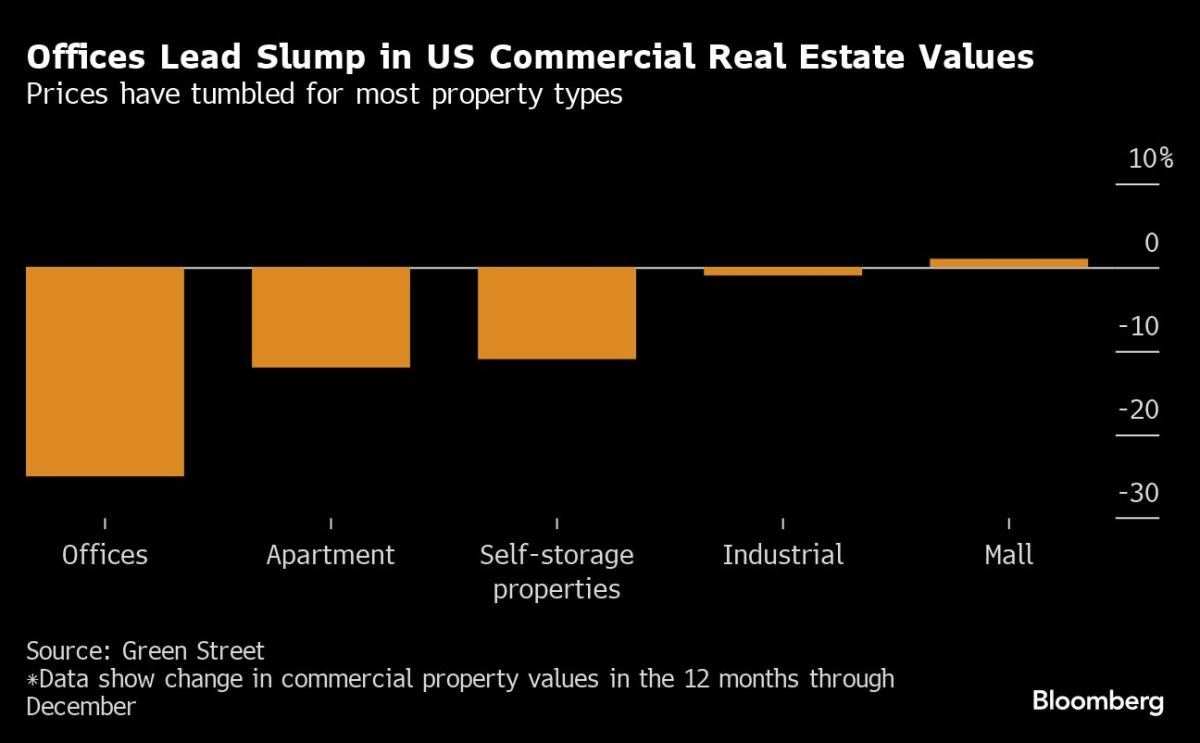(Bloomberg) — The US commercial real estate market has been in turmoil since the onset of the Covid-19 pandemic. But New York Community Bancorp delivered a reminder that some lenders are only just beginning to see the pain.
Most Read from Bloomberg
The bank’s decisions to slash its dividend and stockpile reserves sent its stock down a record 38% and dragged the KBW Regional Banking Index to its worst day since the collapse of Silicon Valley Bank last March. Japanese lender Aozora Bank Ltd. added to the property jitters by warning of a loss tied to investments in US commercial real estate, sending shares plunging in Asia trading.
The concern reflects the ongoing slide in commercial property values coupled with the difficulty predicting which specific loans might unravel. Setting that stage is a pandemic-induced shift to remote work and a rapid runup in interest rates, which have made it more expensive for strained borrowers to refinance. Billionaire investor Barry Sternlicht warned this week that the office market is headed for more than $1 trillion in losses.
For lenders, that means the prospect of more defaults as some landlords struggle to pay loans or simply walk away from buildings.
“This is a huge issue that the market has to reckon with,” said Harold Bordwin, a principal at Keen-Summit Capital Partners LLC in New York, which specializes in renegotiating distressed properties. “Banks’ balance sheets aren’t accounting for the fact that there’s lots of real estate on there that’s not going to pay off at maturity.”
Moody’s Investors Service said it’s reviewing whether to lower New York Community Bancorp’s credit rating to junk after Wednesday’s developments.
Read More: NY Community Bancorp Plunges as Real Estate Risks Jolt Market
Banks are facing roughly $560 billion in commercial real estate maturities by the end of 2025, according to Trepp, representing more than half of the total property debt coming due over that period. Regional lenders in particular are more exposed to the industry, and stand to be hurt harder than their larger peers because they lack the large credit card portfolios or investment banking businesses that can insulate them.
Commercial real estate loans account for 28.7% of assets at small banks, compared with just 6.5% at bigger lenders, according to a JPMorgan Chase & Co. report published in April. That exposure has prompted additional scrutiny from regulators, already on high alert following last year’s regional banking tumult.
While real estate troubles, particularly for offices, have been apparent in the nearly four years since the pandemic, the property market has in some ways been in limbo: Transactions have plunged because of uncertainty among both buyers and sellers over how much buildings are worth. Now, the need to address looming debt maturities — and the prospect of Federal Reserve interest rate cuts — are expected to spark more deals that will bring clarity to just how much values have fallen.
Those declines could be stark. The Aon Center, the third-tallest office tower in Los Angeles, recently sold for $147.8 million, about 45% less than its previous purchase price in 2014.
“Banks — community banks, regional banks — have been really slow to mark things to market because they didn’t have to, they were holding them to maturity,” said Bordwin. “They are playing games with what is the real value of these assets.”
Multifamily Loans
Exacerbating the nervousness surrounding smaller lenders is the unpredictability of when and where soured real estate loans can occur, with just a few defaults having the potential to wreak havoc. New York Community Bancorp said its increase in charge-offs were related to a co-op building and an office property.
While offices are a particular area of concern for real estate investors, the company’s largest real estate exposure comes from multifamily buildings, with the bank carrying about $37 billion in apartment loans. Nearly half of those loans are backed by rent-regulated buildings, making them vulnerable to New York state regulations passed in 2019 that strictly limit landlords’ ability to raise rents.
At the end of last year, the Federal Deposit Insurance Corp. took a 39% discount when it sold about $15 billion in loans backed by rent-regulated buildings. In another indication of the challenges facing these buildings, roughly 4.9% of New York City rent-stabilized buildings with securitized loans were in delinquency as of December, triple the rate for other apartment buildings, according to a Trepp analysis based on when the properties were built.
‘Conservative Lender’
New York Community Bancorp, which acquired part of Signature Bank last year, said Wednesday that 8.3% of its apartment loans were considered criticized, meaning they have an elevated risk of default.
“NYCB was a much more conservative lender when compared to Signature Bank,” said David Aviram, principal at Maverick Real Estate Partners. “Yet because loans secured by rent-stabilized multifamily properties makes up a larger percentage of NYCB’s CRE book in comparison to its peers, the change in the 2019 rent laws may have a more significant impact.”
Pressure is growing on banks to reduce their exposure to commercial real estate. While some banks have held off on large loan sales due to uncertainty over the past year, they’re expected to market more debt now as the market thaws.
Canadian Imperial Bank of Commerce recently started marketing loans on struggling US office properties. While US office loans make up just 1% of their total asset portfolio, CIBC’s earnings were dragged down by higher provisions for credit losses in the segment.
“The percentage of loans that banks have so far been reported as delinquent are a drop in the bucket compared to the defaults that will occur throughout 2024 and 2025,” said Aviram. “Banks remain exposed to these significant risks, and the potential decline in interest rates in the next year won’t solve bank problems.”
–With assistance from Sally Bakewell.
(Updates with Aozora Bank real estate warning in second paragraph)
Most Read from Bloomberg Businessweek
©2024 Bloomberg L.P.

Jessica Roberts is a seasoned business writer who deciphers the intricacies of the corporate world. With a focus on finance and entrepreneurship, she provides readers with valuable insights into market trends, startup innovations, and economic developments.







